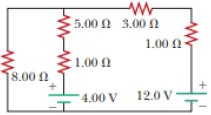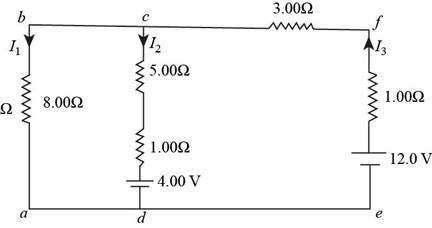
The circuit shown in Figure P27.17 is connected for 2.00 min. (a) Determine the current in each branch of the circuit. (b) Find the energy delivered by each battery. (c) Find the energy delivered to each resistor. (d) Identify the type of energy storage transformation that occurs in the operation of the circuit. (e) Find the total amount of energy transformed into internal energy in the resistors.

(a)
Answer to Problem 28.23P
Explanation of Solution
Given info: The circuit connected for
Consider the figure given below,

Figure (1)
From the Kirchhoff law,
In the circuit given above there are two loops
Apply Kirchhoff current law for the loop
Substitute
Multiply
Add equation (3) and equation (2).
Substitute
Substitute
Conclusion:
Therefore, the current in each branch of the circuit is
(b)
Answer to Problem 28.23P
Explanation of Solution
Given info: The circuit connected for
Formula to calculate energy for the battery is,
Here,
For
Substitute
For
Substitute
Conclusion:
Therefore, the energy delivered by each battery is
(c)
Answer to Problem 28.23P
Explanation of Solution
Given info: The circuit connected for
Formula to calculate energy transformed into internal energy in the resistors is,
Here,
For
Substitute
For
Substitute
For
Substitute
For
Substitute
For
Substitute
Conclusion:
Therefore, the energy delivered to each resistors is
(d)
Answer to Problem 28.23P
Explanation of Solution
Given info: The circuit connected for
For the
For the
Conclusion:
Therefore, the potential energy in the
(e)
Answer to Problem 28.23P
Explanation of Solution
Given info: The diagram is given above in Figure (1).
Formula for the total amount of energy transformed into internal energy in the resistors is,
Substitute
Conclusion:
Therefore, the total amount of energy transformed into internal energy in the resistors is
Want to see more full solutions like this?
Chapter 28 Solutions
Physics for Scientists and Engineers, Technology Update (No access codes included)
- (a) Can the circuit shown in Figure P18.29 be reduced to a single resistor connected to the batteries? Explain. (b) Find the magnitude of the current and its direction in each resistor. Figure P18.29arrow_forwardIn the circuit of Figure P21.51, determine (a) the current in each resistor and (b) the potential difference across the 200- resistor. Figure P21.51arrow_forwardThe circuit shown in Figure P21.47 is connected for 2.00 min. (a) Determine the current in each branch of the circuit. (b) Find the energy delivered by each battery. (c) Find the energy delivered to each resistor. (d) Identify the type of energy storage transformation that occurs in the operation of the circuit. (e) Find the total amount of energy transformed into internal energy in the resistors. Figure P21.47 Problems 47 and 48.arrow_forward
- Consider the circuit shown in Figure P21.39. Find (a) the current in the 20.0- resistor and (b) the potential difference between points a and b. Figure P21.39arrow_forwardA battery is used to charge a capacitor through a resistor as shown in Figure P27.44. Show that half the energy supplied by the battery appears as internal energy in the resistor and half is stored in the capacitor. Figure P27.44arrow_forwardCalculate the equivalent resistance between points P and Q of the electrical network shown in Figure P29.80.arrow_forward
- Lightbulb A is marked 25.0 W 120. V, and lightbulb B is marked 100. W 120. V. These labels mean that each lightbulb has its respective power delivered to it when it is connected to a constant 120.-V source. (a) Find the resistance of each lightbulb. (b) During what time interval does 1.00 C pass into lightbulb A? (c) Is this charge different upon its exit versus its entry into the lightbulb? Explain. (d) In what time interval does 1.00 J pass into lightbulb A? (e) By what mechanisms does this energy enter and exit the lightbulb? Explain. (f) Find the cost of running lightbulb A continuously for 30.0 days, assuming the electric company sells its product at 0.110 per kWh.arrow_forwardA lightbulb is connected to a variable power supply. As the potential across the bulb is varied, the resulting current and the filaments temperature are measured. The data are listed in Table P28.38. a. Find R for each entry in Table P28.38, and then plot R as a function of T. b. Assume that room temperature is at 293 K. Find R0 (resistance at room temperature). Comment on your result.arrow_forwardIn the circuit of Figure P27.20, the current I1 = 3.00 A and the values of for the ideal battery and R are unknown. What are the currents (a) I2 and (b) I3? (c) Can you find the values of and R? If so, find their values. If not, explain. Figure P27.20arrow_forward
- Figure P18.19 shows a Wheatstone bridge, a circuit used to precisely measure an unknown resistance R by varying Rvar until the ammeter reads zero current and the bridge is said to be balanced. If the bridge is balanced with Rvar = 9.00 , find (a) the value of the unknown resistance Rand (b) the current in the 1.00 resistor. (Hint: With the bridge balanced, the wire through the ammeter can effectively be removed from the circuit, leaving two pairs of resistors in parallel.) Figure Pl8.19arrow_forwardFigure P18.19 shows a Wheatstone bridge, a circuit used to precisely measure an unknown resistance R by varying Rvar until the ammeter reads zero current and the bridge is said to be balanced. If the bridge is balanced with Rvar = 9.00 , find (a) the value of the unknown resistance Rand (b) the current in the 1.00 resistor. (Hint: With the bridge balanced, the wire through the ammeter can effectively be removed from the circuit, leaving two pairs of resistors in parallel.) Figure Pl8.19arrow_forwardWhat is the equivalent resistance between points a and b of the six resistors shown in Figure P29.70? FIGURE P29.70arrow_forward
 Physics for Scientists and Engineers with Modern ...PhysicsISBN:9781337553292Author:Raymond A. Serway, John W. JewettPublisher:Cengage Learning
Physics for Scientists and Engineers with Modern ...PhysicsISBN:9781337553292Author:Raymond A. Serway, John W. JewettPublisher:Cengage Learning Physics for Scientists and EngineersPhysicsISBN:9781337553278Author:Raymond A. Serway, John W. JewettPublisher:Cengage Learning
Physics for Scientists and EngineersPhysicsISBN:9781337553278Author:Raymond A. Serway, John W. JewettPublisher:Cengage Learning Principles of Physics: A Calculus-Based TextPhysicsISBN:9781133104261Author:Raymond A. Serway, John W. JewettPublisher:Cengage Learning
Principles of Physics: A Calculus-Based TextPhysicsISBN:9781133104261Author:Raymond A. Serway, John W. JewettPublisher:Cengage Learning College PhysicsPhysicsISBN:9781305952300Author:Raymond A. Serway, Chris VuillePublisher:Cengage Learning
College PhysicsPhysicsISBN:9781305952300Author:Raymond A. Serway, Chris VuillePublisher:Cengage Learning College PhysicsPhysicsISBN:9781285737027Author:Raymond A. Serway, Chris VuillePublisher:Cengage Learning
College PhysicsPhysicsISBN:9781285737027Author:Raymond A. Serway, Chris VuillePublisher:Cengage Learning Physics for Scientists and Engineers: Foundations...PhysicsISBN:9781133939146Author:Katz, Debora M.Publisher:Cengage Learning
Physics for Scientists and Engineers: Foundations...PhysicsISBN:9781133939146Author:Katz, Debora M.Publisher:Cengage Learning





